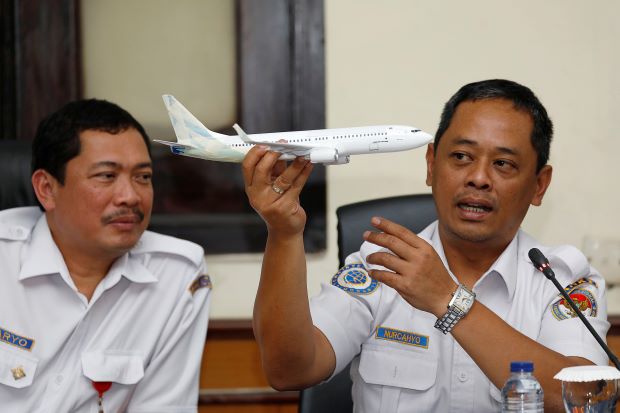JAKARTA, (Reuters) – A Lion Air jet that crashed into the sea off Indonesia last month was not in an airworthy condition on its second-to-last flight, when pilots experienced similar problems to those on its doomed last journey, investigators said on Wednesday.
Contact with the Boeing 737 MAX jet was lost 13 minutes after it took off on Oct. 29 from the capital, Jakarta, heading north to the tin-mining town of Pangkal Pinang.
In a preliminary report, Indonesia’s transport safety committee (KNKT) focused on the airline’s maintenance practices and pilot training and a Boeing anti-stall system but did not give a cause for the crash that killed all 189 people on board.
 The report unveiled fresh details of efforts by pilots to steady the jet as they reported a “flight control problem”, including the captain’s last words to air traffic control asking to be cleared to “five thou” or 5,000 feet.
The report unveiled fresh details of efforts by pilots to steady the jet as they reported a “flight control problem”, including the captain’s last words to air traffic control asking to be cleared to “five thou” or 5,000 feet.
Lion Air CEO Edward Sirait on Wednesday evening rejected some media reports quoting KNKT that the airline’s Boeing 737 passenger jet that crashed on Oct. 29 was not airworthy since its penultimate flight from Denpasar to Jakarta.
It had been cleared as airworthy by Lion Air engineers on that flight as well as its final flight, KNKT investigator Nurcahyo Utomo said earlier in the day.
“I think pilots can judge for themselves whether to continue,” said Lion Air Managing Director Daniel Putut, a former pilot.
Utomo, in contrast, pointed to multiple problems, including the “severe” issue of stall warnings occurring in tandem on the Bali-Jakarta flight that were enough for the KNKT to determine the flight should not have continued.
Information retrieved from the flight data recorder showed the “stick shaker” was vibrating the captain’s controls, warning of a stall throughout most of the flight. The captain was using his controls to bring the plane’s nose up, but an automated anti-stall system was pushing it down.
Pilots flying the same plane a day earlier had experienced a similar problem, en route from Denpasar, Bali to Jakarta, until they used switches to shut off the system and used manual controls to fly and stabilise the plane, KNKT said.
“The flight from Denpasar to Jakarta experienced stick shaker activation during the takeoff rotation and remained active throughout the flight,” the committee said.
“This condition is considered un-airworthy” and the flight should have been “discontinued”.
The pilots of that flight reported problems to Lion Air’s maintenance team, which checked the jet and cleared it for take-off the next morning.
Former Boeing flight control engineer Peter Lemme said stick shaker activation was “very distracting and unnerving”.
“It’s not something you ever want to have happen as a pilot,” he said.
Utomo said the agency had not determined if the anti-stall system, which was not explained to pilots in manuals, was a contributing factor.
“We still don’t know yet, if it contributed or not,” he said in response to a question. “It is too early to conclude.”
In a statement, Boeing drew attention in detail to a list of airline maintenance actions set out in the report but stopped short of blaming ground workers or pilots for the accident.
